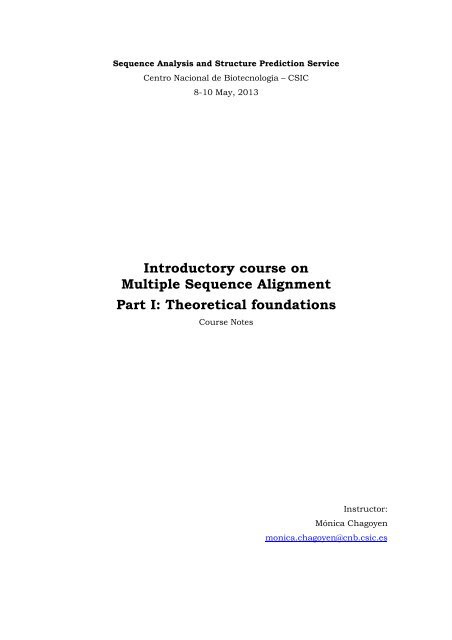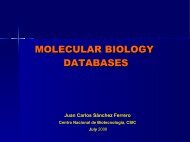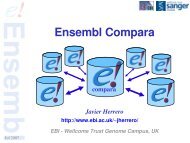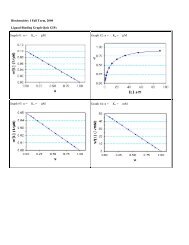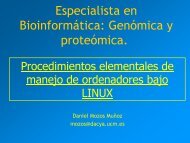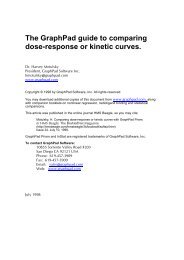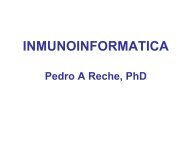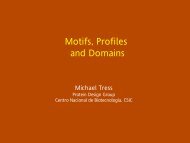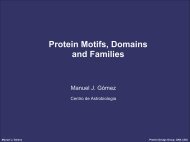Practical Course on Multiple Sequence Alignment - CNB - Protein ...
Practical Course on Multiple Sequence Alignment - CNB - Protein ...
Practical Course on Multiple Sequence Alignment - CNB - Protein ...
Create successful ePaper yourself
Turn your PDF publications into a flip-book with our unique Google optimized e-Paper software.
<strong>Sequence</strong> Analysis and Structure Predicti<strong>on</strong> Service<br />
Centro Naci<strong>on</strong>al de Biotecnología – CSIC<br />
8-10 May, 2013<br />
Introductory course <strong>on</strong><br />
<strong>Multiple</strong> <strong>Sequence</strong> <strong>Alignment</strong><br />
Part I: Theoretical foundati<strong>on</strong>s<br />
<str<strong>on</strong>g>Course</str<strong>on</strong>g> Notes<br />
Instructor:<br />
Mónica Chagoyen<br />
m<strong>on</strong>ica.chagoyen@cnb.csic.es
C<strong>on</strong>tents<br />
C<strong>on</strong>tents ........................................................................................................................................ 3<br />
Introducti<strong>on</strong>.................................................................................................................................. 5<br />
Some notes <strong>on</strong> protein evoluti<strong>on</strong>............................................................................................ 6<br />
Mutati<strong>on</strong>s ............................................................................................................................................7<br />
Variati<strong>on</strong> am<strong>on</strong>g species .....................................................................................................................7<br />
Variati<strong>on</strong> within species......................................................................................................................7<br />
Domain shuffling ................................................................................................................................8<br />
Finding sequences to align .......................................................................................................... 9<br />
Fundamentals: pair-wise sequence alignment...................................................................... 9<br />
Similarity scores .................................................................................................................................9<br />
Algorithms (Dynamic programming) ...............................................................................................12<br />
Basic Local <strong>Alignment</strong> Search Tool (BLAST).................................................................... 13<br />
The algorithm....................................................................................................................................13<br />
Significance of an alignment score ...................................................................................................14<br />
Performing multiple sequence alignment.................................................................................. 15<br />
Progressive methods ............................................................................................................. 16<br />
ClustalW ...........................................................................................................................................16<br />
T-Coffee............................................................................................................................................16<br />
MUSCLE ..........................................................................................................................................17<br />
Iterative methods .................................................................................................................. 17<br />
MAFFT .............................................................................................................................................17<br />
Choosing the right MSA software ....................................................................................... 18<br />
<strong>Alignment</strong> visualizati<strong>on</strong> and editing.................................................................................... 18<br />
Jalview ..............................................................................................................................................19<br />
Representing multiple sequence alignments....................................................................... 20<br />
C<strong>on</strong>sensus sequence..........................................................................................................................20<br />
<strong>Sequence</strong> logos .................................................................................................................................20<br />
Working with profiles................................................................................................................. 23<br />
<strong>Sequence</strong> patterns ................................................................................................................. 23<br />
PROSITE patterns.............................................................................................................................24<br />
Positi<strong>on</strong>-specific scoring matrices (PSSM) ......................................................................... 24<br />
Hidden Markov Models (HMM) ......................................................................................... 25<br />
Domain/Family databases .................................................................................................... 25<br />
Pfam..................................................................................................................................................26<br />
SMART.............................................................................................................................................26<br />
InterPro .............................................................................................................................................26<br />
Profile searches ..................................................................................................................... 27<br />
<strong>Sequence</strong>-profile searches.................................................................................................................27
Profile-sequence searches .................................................................................................................27<br />
Profile-profile methods .....................................................................................................................28<br />
C<strong>on</strong>tent sources and bibliography ............................................................................................. 29<br />
Online resources.................................................................................................................... 29<br />
Books and articles ................................................................................................................. 29
Introducti<strong>on</strong><br />
A multiple sequence alignment (MSA) is a sequence alignment of three or more<br />
biological sequences, generally protein or DNA. In many cases, the input set of<br />
query sequences are assumed to have an evoluti<strong>on</strong>ary relati<strong>on</strong>ship by which<br />
they share a lineage and are descended from a comm<strong>on</strong> ancestor.<br />
Example: A multiple sequence alignment corresp<strong>on</strong>ding to the WW domain<br />
(Source: SMART database)<br />
O54971/1-33 PLPPGWEKRT DSN-GRVYFV N---HNTRIT QWEDPRS<br />
O43165/1-33 GLPSGWEERK DAK-GRTYYV N---HNNRTT TWTRPIM<br />
NED4_HUMAN/1-33 PLPPGWEERT HTD-GRIFYI N---HNIKRT QWEDPRL<br />
O14326/1-33 PLPSGWEMRL TNS-ARVYFV D---HNTKTT TWDDPRL<br />
O43165_2/1-33 FLPPGWEMRI APN-GRPFFI D---HNTKTT TWEDPRL<br />
PIN1_HUMAN/1-34 KLPPGWEKRM SRSSGRVYYF N---HITNAS QWERPSG<br />
NED4_HUMAN_1/1-0 PLPPGWEERQ DIL-GRTYYV N---HESRRT QWKRPTP<br />
O75853/1-33 PLPPGWEVRS TVS-GRIYFV D---HNNRTT QFTDPRL<br />
PUB1_SCHPO_2/1-0 RLPPGWERRT DNL-GRTYYV D---HNTRST TWIRPNL<br />
YA65_CHICK/1-33 PLPPGWEMAK TPS-GQRYFL N---HIDQTT TWQDPRK<br />
I83196_2/1-33 GLPPGWEEKQ DDR-GRSYYV D---HNSKTT TWSKPTM<br />
YA65_MOUSE/1-33 PLPDGWEQAM TQD-GEVYYI N---HKNKTT SWLDPRL<br />
<strong>Multiple</strong> sequence alignment also refers to the process of aligning such<br />
sequence set. Because three or more sequences of biologically relevant length<br />
can be difficult and are almost always time-c<strong>on</strong>suming to align by hand,<br />
computati<strong>on</strong>al algorithms are used to produce and analyze the alignments.<br />
MSAs require more sophisticated methodologies than pair-wise alignments<br />
because they are more computati<strong>on</strong>ally complex. Most multiple alignment<br />
programs use heuristic methods (see box) rather than global optimizati<strong>on</strong><br />
because identifying the optimal alignment between more than a few sequences<br />
of moderate length is prohibitively computati<strong>on</strong>ally expensive.<br />
Heuristic: In computer science, a heuristic is a technique designed to solve a<br />
problem that ignores whether the soluti<strong>on</strong> can be proven to be correct, but<br />
which usually produces a good soluti<strong>on</strong> or solves a simpler problem that<br />
c<strong>on</strong>tains or intersects with the soluti<strong>on</strong> of the more complex problem.<br />
<strong>Alignment</strong> is not a single problem but rather a collecti<strong>on</strong> of many quite diverse<br />
questi<strong>on</strong>s that all have in comm<strong>on</strong> the search for sequence similarity. Starting<br />
from the definiti<strong>on</strong> of alignment, there are two biologically meaningful<br />
formulati<strong>on</strong>s – <strong>on</strong>e based <strong>on</strong> the desire to find evoluti<strong>on</strong>ary relati<strong>on</strong>ships and<br />
<strong>on</strong>e based <strong>on</strong> the desire to find putative functi<strong>on</strong>al relati<strong>on</strong>ships.<br />
Given the amino acid sequences of a set of proteins to be compared, an<br />
alignment displays the residues for each protein <strong>on</strong> a single line, with gaps (“–<br />
”) inserted such that “equivalent” residues appear in the same column. The<br />
5
precise meaning of equivalence is generally c<strong>on</strong>text dependent: for the<br />
phylogeneticist, equivalent residues have comm<strong>on</strong> evoluti<strong>on</strong>ary ancestry; for<br />
the structural biologist, equivalent residues corresp<strong>on</strong>d to analogous positi<strong>on</strong>s<br />
bel<strong>on</strong>ging to homologous folds in a set of proteins; for the molecular biologist,<br />
equivalent residues play similar functi<strong>on</strong>al roles in their corresp<strong>on</strong>ding<br />
proteins. In each case, an alignment provides a bird’s eye view of the<br />
underlying evoluti<strong>on</strong>ary, structural, or functi<strong>on</strong>al c<strong>on</strong>straints characterizing a<br />
protein family in a c<strong>on</strong>cise, visually intuitive format.<br />
Many bioinformatic methods rely <strong>on</strong> MSAs. Success of methods relies <strong>on</strong><br />
quality of alignment. MSA a difficult problem, although current automatic<br />
approaches are good, usually they can be improved by human interventi<strong>on</strong> to<br />
yield better alignments and hence better analysis. It is difficult to teach how to<br />
do this well - depends <strong>on</strong> obtaining experience. This course aims to provide a<br />
starting point to obtain this experience.<br />
A typical multiple sequence alignment workflow will be:<br />
1. Clearly formulate the questi<strong>on</strong> you want to answer. E.g.: “What is the<br />
sec<strong>on</strong>dary structure predicti<strong>on</strong> for protein sequence”<br />
2. Collect a set of sequences to address this questi<strong>on</strong>. E.g. using a<br />
BLAST database search.<br />
3. Create and examine initial automatic MSA. E.g. align using Clustal<br />
and examine in JalView<br />
4. Adjust the set of sequences to obtain an optimal set. E.g. remove<br />
unrelated sequences, add sequences from additi<strong>on</strong>al searches.<br />
5. Manually adjust alignment to correct automatically-introduced<br />
errors.<br />
Some notes <strong>on</strong> protein evoluti<strong>on</strong><br />
The evoluti<strong>on</strong>ary variati<strong>on</strong>s of a protein provide much informati<strong>on</strong> about the<br />
protein itself. Evoluti<strong>on</strong>ary divergence into different species has resulted in<br />
many variants of the same protein, all with essentially the same biological<br />
functi<strong>on</strong> but different amino acid sequences. The differences and similarities<br />
of the amino acid sequences of these variants reflect the c<strong>on</strong>straints of<br />
structure and functi<strong>on</strong> for that protein.<br />
The number of possible RNA, DNA, or protein sequences is so great that it is<br />
implausible that similar l<strong>on</strong>g sequences could have arisen by any mechanism<br />
other than evoluti<strong>on</strong>ary divergence from the same ancestor.<br />
Nucleic acids and proteins that have evolved from a comm<strong>on</strong> ancestor are said<br />
to be homologous. The sequences of homologous genes and proteins were<br />
identical at the time they originated by replicati<strong>on</strong> of a single gene.<br />
Subsequently the two genes accumulate mutati<strong>on</strong>al changes, and the<br />
sequences of homologous genes and proteins can be identical, similar to<br />
varying degrees, or unrecognizably dissimilar because of extensive mutati<strong>on</strong>.<br />
<strong>Protein</strong>s and genes are either homologous or not, because they either did or<br />
did not descent from a comm<strong>on</strong> ancestor.<br />
The <strong>on</strong>ly explanati<strong>on</strong> other than divergence for similarities am<strong>on</strong>g sequences is<br />
c<strong>on</strong>vergence, in which two or more unrelated sequences have become similar<br />
under the pressure selecti<strong>on</strong> for similar functi<strong>on</strong>s. C<strong>on</strong>vergence is a fairly<br />
6
comm<strong>on</strong> evoluti<strong>on</strong>ary phenomen<strong>on</strong> at the macroscopic level and is even<br />
encountered at the level of protein three-dimensi<strong>on</strong>al structure. There are,<br />
however, no instances in which nucleic acid or protein sequences have been<br />
shown c<strong>on</strong>clusively to have become substantially similar by c<strong>on</strong>vergence. On<br />
the other hand, proving evoluti<strong>on</strong>ary c<strong>on</strong>vergence <strong>on</strong>ly from extant sequences<br />
is inherently difficult, so the possibility cannot be dismissed completely.<br />
Mutati<strong>on</strong>s<br />
Mutati<strong>on</strong>s are both the raw material and the driving for of evoluti<strong>on</strong>, whereas<br />
natural selecti<strong>on</strong> modulates the rate of divergence.<br />
A variety of mutati<strong>on</strong>s occur to DNA and RNA, by numerous and complex<br />
mechanisms. Simplest and most frequent is the replacement of <strong>on</strong>e nucleotide<br />
by another; inserti<strong>on</strong>s and deleti<strong>on</strong>s of <strong>on</strong>e or more nucleotides are also<br />
comm<strong>on</strong>. More complex rearrangements of DNA are less comm<strong>on</strong> but of<br />
greater c<strong>on</strong>sequence.<br />
Variati<strong>on</strong> am<strong>on</strong>g species<br />
The more closely related the organisms, the more similar the sequences of<br />
their genes and proteins are found to be. Closely related proteins generally<br />
differ <strong>on</strong>ly by replacement of <strong>on</strong>e amino acid by another at a few positi<strong>on</strong>s in<br />
the polypeptide chain. Less frequent are differences in the total number of<br />
residues, which are due to the deleti<strong>on</strong> or inserti<strong>on</strong> of residues within or at<br />
either end of the polypeptide chain. In more distant relati<strong>on</strong>ships, the<br />
numbers and natures of sequence differences can increase greatly.<br />
In general, the amino acid replacements that occur during protein divergence<br />
are n<strong>on</strong> random, both in the extent to which various residues change and in<br />
the number of amino acids that replace each other. The most prevalent<br />
replacements occur between amino acids with similar side chains. This bias in<br />
amino acid replacements presumably reflects the role of selecti<strong>on</strong>; <strong>on</strong>ly those<br />
mutati<strong>on</strong>s that do not disrupt the functi<strong>on</strong> of the protein survive.<br />
Variati<strong>on</strong> within species<br />
DNA is known to be a very dynamic molecule that undergoes a wide variety of<br />
alterati<strong>on</strong>s and modificati<strong>on</strong>s, and gene duplicati<strong>on</strong>s occur naturally and<br />
frequently. With two copies of a gene available in a genome, <strong>on</strong>e copy could<br />
provide the necessary original functi<strong>on</strong> while the other accumulated mutati<strong>on</strong>s<br />
that altered its functi<strong>on</strong>. If this altered copy evolved eventually to serve a new<br />
functi<strong>on</strong>, it would tend to be retained in the genome and passed <strong>on</strong> to later<br />
generati<strong>on</strong>s.<br />
Many genes and proteins of an organism are homologous and are obviously<br />
the products of gene duplicati<strong>on</strong>. The genes of such homologous proteins in a<br />
genome are said to comprise a gene family.<br />
Genes that occupy the same gene locus in different species, and protein<br />
products of such genes, are said to be orthologous, whereas genes at different<br />
loci that are related by gene duplicati<strong>on</strong> are designated paralogous (see Figure<br />
1). The phylogenies of species can be rec<strong>on</strong>structed <strong>on</strong>ly by comparing<br />
orthologous genes. The differences between paralogous genes or proteins from<br />
different species are not related to the time since divergence of the species, but<br />
to the time since gene duplicati<strong>on</strong>.<br />
7
Figure 1: Illustrati<strong>on</strong> of homologous relati<strong>on</strong>ships: orthologs and paralogs.<br />
Domain shuffling<br />
Many proteins, especially those unique to vertebrates, have mosaic structure<br />
in which various segments appear to have had different origins. Such a<br />
protein gives the impressi<strong>on</strong> of having been assembled by stringing modules<br />
together. Each module usually corresp<strong>on</strong>ds to an entire structural and<br />
functi<strong>on</strong>al domain of a protein.<br />
Several different molecular mechanisms for domain shuffling have been<br />
proposed. Since the domains are often correlated with ex<strong>on</strong> boundaries, ex<strong>on</strong><br />
shuffling is believed to be <strong>on</strong>e of the major forces driving domain shuffling.<br />
Some other mechanisms might have been involved in domains shuffling, such<br />
as the simple fusi<strong>on</strong> of genes and recruitment of mobile elements.<br />
8
Finding sequences to align<br />
Very often the selecti<strong>on</strong> of sequences to align will be made using sequence<br />
similarity searches against a sequence database. The most comm<strong>on</strong>ly<br />
programs to perform these searches are the BLAST suite.<br />
Because searches <strong>on</strong> a sequence database are perform using successive pairwise<br />
alignments with the query sequence and each sequence in the database,<br />
it is c<strong>on</strong>venient to revise some fundamentals c<strong>on</strong>cepts of pair-wise sequence<br />
alignments.<br />
Fundamentals: pair-wise sequence alignment<br />
Let a = (a 1, . . . , a m) and b = (b 1, . . . , b n) be two sequences and a set of<br />
elementary operati<strong>on</strong>s including inserti<strong>on</strong>, deleti<strong>on</strong>, and substituti<strong>on</strong>.<br />
An alignment of a and b is a <strong>on</strong>e-to-<strong>on</strong>e corresp<strong>on</strong>dence such that each<br />
element of <strong>on</strong>e sequence corresp<strong>on</strong>ds either to an element of the opposite<br />
sequence or to a null element indicating the presence of a gap.<br />
There are two types of sequence alignment,<br />
global and local. In global alignment, an<br />
attempt is made to align the entire sequence,<br />
using as many residues, up to both ends of<br />
each sequence. <strong>Sequence</strong>s that are quite<br />
similar and approximately the same length<br />
are suitable candidates for global alignment.<br />
In local alignment, stretches of sequence with the highest density of matches<br />
are aligned, thus generating <strong>on</strong>e or more islands of matches or subalignments<br />
in the aligned sequences. Local alignments are more suitable for aligning<br />
sequences that are similar al<strong>on</strong>g some of their lengths but dissimilar in others,<br />
sequences that differ in length or sequences that share a c<strong>on</strong>served regi<strong>on</strong> or<br />
domain.<br />
Similarity scores<br />
In c<strong>on</strong>trast to homology, similarity is a quantitative measure and therefore we<br />
need to establish a numerical value from the sequence alignment. Many<br />
different methods have been proposed and used to address the questi<strong>on</strong> of an<br />
appropriate measure of similarity.<br />
The simplest method involves counting the proporti<strong>on</strong> of identical residues in<br />
aligned sequences relative to the alignment overall length, including gaps. This<br />
provides a percentage of identity that also takes into account the size of all<br />
gaps in the alignment.<br />
9
A more complete method, like the <strong>on</strong>es used in most pair-wise alignments,<br />
computes a score for the sequence alignment by summing individual scores<br />
for stacked residues and subtracting a penalty for gaps:<br />
• Individual scores for aligning residues are provided by scoring<br />
matrices, the simplest <strong>on</strong>e being the identity matrix scoring 1 for<br />
identical residues and 0 otherwise. Many other matrices have also been<br />
designed to reflect amino acid properties. These replacement scores<br />
were either computed from physical and chemical properties or from<br />
observed frequencies of replacement of an amino acid by another in<br />
related proteins. Although real properties would seem to provide the<br />
most rati<strong>on</strong>al similarity scale, statistical scores actually reflect the effect<br />
of these properties <strong>on</strong> protein evoluti<strong>on</strong> and mutati<strong>on</strong>s allowed by<br />
natural selecti<strong>on</strong>. Statistical matrices eventually proved to be the most<br />
efficient <strong>on</strong>es and today, most similarity search programs use the<br />
statistical BLOSUM or PAM matrices built from reference alignments.<br />
• The most widely used gap penalty is the so-called affine gap penalty. It<br />
is computed as a linear functi<strong>on</strong> of the number of gaps and their total<br />
length. Parameters provide c<strong>on</strong>trol over the relative importance of<br />
number and length of gaps: a larger “gap opening penalty” will favor<br />
fewer but somewhat larger gaps, whereas a larger “gap extensi<strong>on</strong><br />
penalty” would give preference to small gaps.<br />
Some examples of different scoring methods are provided in figure 2 examples<br />
of alignment scores<br />
Figure 2: Examples of scores methods<br />
Scoring matrices<br />
In the scoring matrices, also known as amino acid substituti<strong>on</strong> matrices,<br />
amino acids are listed both across the top of a matrix and down the side, and<br />
each matrix positi<strong>on</strong> is filled with a score that reflects how often <strong>on</strong>e amino<br />
10
acid would have been paired with the other in an alignment of related protein<br />
sequences.<br />
All modern amino acid score matrices are estimated from frequencies observed<br />
in trusted alignment data, using some procedure to make a series of related<br />
matrices that are appropriate for different expected divergence.<br />
PAM (Percent Accepted Mutati<strong>on</strong>) matrices<br />
This family of matrices lists the likelihood of change from <strong>on</strong>e amino acid to<br />
another in homologous protein sequences during evoluti<strong>on</strong>. Each matrix gives<br />
the changes expected for a given period of evoluti<strong>on</strong>ary time, evidenced by<br />
decreased sequence similarity as genes encoding the same protein diverge with<br />
increased evoluti<strong>on</strong>ary time.<br />
The PAM matrices are normalized so that, for instance, the PAM1 matrix gives<br />
substituti<strong>on</strong> probabilities for sequences that have experienced <strong>on</strong>e point<br />
mutati<strong>on</strong> for every hundred amino acids. The mutati<strong>on</strong>s may overlap so that<br />
the sequences reflected in the PAM250 matrix have experienced 250 mutati<strong>on</strong><br />
events for every 100 amino acids, yet <strong>on</strong>ly 80 out of every 100 amino acids<br />
have been affected.<br />
This type of matrix is comm<strong>on</strong>ly known as a substituti<strong>on</strong> matrix. Substituti<strong>on</strong><br />
matrices are used to derive scoring matrices used to assess the similarity of<br />
two aligned sequences. For example, an 18% probability of replacing arginine<br />
with lysine (in the substituti<strong>on</strong> matrix) is turned into a score of 3 in the<br />
scoring matrix. The calculati<strong>on</strong> uses the ratio of the probability value and the<br />
frequency of the original amino acid (arginine) in known sequences, known as<br />
the log-odds ratio.<br />
BLOSUM<br />
Figure 3: BLOSUM62 scoring matrix<br />
Henikoff & Henikoff took a big database of trusted alignments (the BLOCKS<br />
database), and counted pair-wise sequence alignments related by less than<br />
some threshold percentage identity. A threshold of 62% identity or less<br />
resulted in the target frequencies for the BLOSUM62 matrix. An 80%<br />
threshold gave the more highly c<strong>on</strong>served target frequencies of the BLOSUM80<br />
11
matrix, and a 45% threshold gave the more divergent BLOSUM45 matrix.<br />
Empirically, the BLOSUM matrices have performed very well. BLOSUM62 has<br />
become a de facto standard for many protein alignment programs.<br />
Generally speaking:<br />
• The BLOSUM matrices are best for detecting local alignments<br />
• BLOSUM62 is the best for detecting the majority of weak protein<br />
similarities (and the matrix used as default in most alignment<br />
programs)<br />
• BLOSUM45 is the best for l<strong>on</strong>g and weak protein similarities.<br />
Table 1: equivalences of PAM and BLOSUM matrices<br />
PAM100<br />
PAM120<br />
PAM160<br />
PAM200<br />
PAM250<br />
BLOSUM90<br />
BLOSUM80<br />
BLOSUM60<br />
BLOSUM52<br />
BLOSUM45<br />
Algorithms (Dynamic programming)<br />
In mathematics and computer science, dynamic programming is a method for<br />
solving complex problems by breaking them down into simpler subproblems.<br />
The key idea is quite simple. In general, to solve a given problem, we need to<br />
solve different parts of the problem (subproblems), then combine the soluti<strong>on</strong>s<br />
of the subproblems to reach the overall soluti<strong>on</strong>. The dynamic programming<br />
approach seeks to solve each subproblem <strong>on</strong>ly <strong>on</strong>ce, thus reducing the<br />
number of computati<strong>on</strong>s.<br />
Dynamic programming is a computati<strong>on</strong>al method that is used to align two<br />
protein or nucleic acid sequences. It provides the very best or optimal<br />
alignment between sequences. Both global and local types of alignments may<br />
be made by simple changes in the basic dynamic programming algorithm. A<br />
global alignment program is based <strong>on</strong> the Needleman-Wunsch algorithm, and<br />
a local alignment program <strong>on</strong> the Smith-Waterman algorithm.<br />
Typically, the problem c<strong>on</strong>sists of transforming <strong>on</strong>e sequence into another,<br />
using individual operati<strong>on</strong>s that either replace, insert, or remove an amino<br />
acid. Each operati<strong>on</strong> has an associated score, as we have seen previously, and<br />
the goal is to find the sequence of individual operati<strong>on</strong>s with the highest total<br />
score.<br />
The problem can be stated naturally as a recursi<strong>on</strong>, a sequence a is optimally<br />
edited into a sequence b by either:<br />
1. inserting the first character of b, and performing an optimal alignment<br />
of a and the tail of b<br />
2. deleting the first character of a, and performing the optimal alignment<br />
of the tail of a and b<br />
3. replacing the first character of a with the first character of b, and<br />
performing optimal alignments of the tails of a and b.<br />
12
The partial alignments can be tabulated in a matrix, where cell (i,j) c<strong>on</strong>tains<br />
the cost of the optimal alignment of a[1..i] to b[1..j]. The score in cell (i,j) can<br />
be calculated by adding the score of the relevant operati<strong>on</strong>s to the score of its<br />
neighboring cells, and selecting the optimum.<br />
Basic Local <strong>Alignment</strong> Search Tool (BLAST)<br />
Searching a sequence database for sequences that are similar to a query<br />
sequence is the most comm<strong>on</strong> type of database similarity search. The search<br />
provides a list of database sequences with which the query sequence can be<br />
aligned.<br />
The dynamic programming (DP) method described above is guaranteed to find<br />
the highest-scoring alignment between two sequences. The time it takes to<br />
complete the alignment is proporti<strong>on</strong>al to the number of DP matrix elements to<br />
compute, which is the product of the sequence lengths. While this is very fast<br />
for comparing any two sequences of reas<strong>on</strong>able length, it is not practical for<br />
searching the current sequence databases, which c<strong>on</strong>tain many milli<strong>on</strong>s of<br />
sequences and many billi<strong>on</strong>s of residues. Therefore heuristic methods have<br />
been developed that can search entire databases much faster. While these<br />
methods do not guarantee finding the absolute best alignments, they have<br />
been finely optimized so that they have very high sensitivities and generally do<br />
obtain the optimal, or near-optimal, alignments. The most comm<strong>on</strong>ly used<br />
method is BLAST.<br />
The algorithm<br />
1. The BLAST algorithm begins by fragmenting the sequence into ‘words’ (of<br />
16-56 nucleotides, or 2-3 amino acids), and, from each word, creating a set<br />
of acceptable ‘syn<strong>on</strong>yms’ that represent possible changes in sequence due<br />
to mutati<strong>on</strong>.<br />
2. Words and their syn<strong>on</strong>yms are scored with respect to how well they match<br />
the query sequence, based <strong>on</strong> scoring matrices (e.g. BLOSUM). The words<br />
that match sufficiently well to have a score above a set threshold value are<br />
carried forward to compare to all the sequences in the database.<br />
3. All the sequences in the database are then scanned for the presence of<br />
these words; sequences carrying two matches within a preset distance from<br />
each other are set aside until the entire database has been scanned. This<br />
“short list” of subject sequences is then carried forward by extending the<br />
alignment outward from the words to determine whether the match<br />
between the query and subject sequences extends bey<strong>on</strong>d the local match<br />
between the subject sequence and the word. Initial “rough” alignments are<br />
extended without gaps to verify that the sequences match bey<strong>on</strong>d the word<br />
hits. If the threshold score for the “ungapped” alignment is high enough<br />
that it suggests that the two sequences are indeed homologs, a sec<strong>on</strong>d<br />
alignment is undertaken in which gaps are allowed to optimize the<br />
alignment. The sequences retrieved after these steps are referred to as the<br />
“subject” sequences.<br />
It is important to note that alignment between the query and subject<br />
sequences does not have to cover the full length of the two sequences.<br />
Therefore, retrieved subject sequences comm<strong>on</strong>ly align with <strong>on</strong>ly a porti<strong>on</strong> of<br />
the query sequence—it is this ‘‘local’’ rather than global quality that is more<br />
than nominally BLAST’s strength.<br />
13
Sometimes it is helpful to mask parts of the query sequence to prevent them<br />
from being aligned with subject sequences. Masking is helpful when the query<br />
sequence has low-complexity regi<strong>on</strong>s, such as stretches of small hydrophobic<br />
amino acids that are comm<strong>on</strong>ly present in transmembrane helices of integral<br />
membrane proteins. Because these features arose from c<strong>on</strong>vergent evoluti<strong>on</strong>,<br />
and their inclusi<strong>on</strong> in BLAST searches could result in spurious hits, it is best<br />
to set the BLAST search parameters to eliminate these sorts of regi<strong>on</strong>s from<br />
word generati<strong>on</strong>, as well as alignment scoring.<br />
Significance of an alignment score<br />
The extend of the sequence similarity between the subject and query<br />
sequences is reported as a raw score, S<br />
in which M is the score from a substituti<strong>on</strong> matrix (e.g. BLOSUM62) for a<br />
particular pair of amino acids i and j, c is the number gaps, O is the penalty<br />
for the existence of a gap, d is the total length of the gaps, and G is the perresidue<br />
penalty for extending the gap.<br />
Obtaining a score for an alignment does not, by itself, tell you whether it is<br />
significant. One needs to determine what is the probability of observing such a<br />
score by chance, given the scoring system used and the lengths of the<br />
sequences being compared.<br />
Bit scores: Because <strong>on</strong>e has the opti<strong>on</strong> of using different parameters (e.g.<br />
scoring matrices) in different BLAST searches, it is ideal to report results in<br />
such a way as to be able to compare alignments made with different scoring<br />
matrices or gap penalties. To do this, S’ values (bit scores) are calculated.<br />
in which λ and K depend <strong>on</strong> the matrices and penalties used.<br />
E-values:<br />
If analyses were to stop here, <strong>on</strong>e would have a list of sequences sorted by bit<br />
scores that would reflect the degree of similarity to the query sequence. But<br />
how do we know if this similarity is significant, or is it <strong>on</strong>ly due to chance? (as<br />
it is the case of having a large database).<br />
To address this issue E-values are calculated from bit scores as:<br />
in which n is the total number of residues (amino or nucleic acids) in the<br />
database, and m is the length of the query sequence. E-values are the number<br />
of subject sequences that can be expected to be retrieved from the database<br />
that have a bit score equal to or greater than the <strong>on</strong>e calculated from the<br />
alignment of the query and subject sequence, based <strong>on</strong> chance al<strong>on</strong>e. E-values<br />
for subject sequences that are very similar to the query sequence will be quite<br />
small, and are widely used as a means to assess the c<strong>on</strong>fidence with which<br />
<strong>on</strong>e should claim the subject sequence sequence(s) and the query sequence as<br />
homologs.<br />
14
Performing multiple sequence<br />
alignment<br />
Most modern programs for c<strong>on</strong>structing multiple sequence alignments (MSAs)<br />
c<strong>on</strong>sist of two comp<strong>on</strong>ents: an objective functi<strong>on</strong> for assessing the quality of<br />
a candidate alignment of a set of input sequences, and an optimizati<strong>on</strong><br />
procedure for identifying the highest scoring alignment with respect to the<br />
chosen objective functi<strong>on</strong>.<br />
In the case of multiple sequence alignment for N sequences, the multiple<br />
alignment score is usually defined to be the summed scores of all N(N – 1)/2<br />
pair-wise projecti<strong>on</strong>s of the original candidate MSA to each pair of input<br />
sequences. This is known as the standard sum-of-pairs (SP) scoring model.<br />
While other alternatives exist, such as c<strong>on</strong>sensus, entropy, or circular sum<br />
scoring, most alignment methods rely <strong>on</strong> the SP objective and its variants.<br />
Unlike the pair-wise case, direct dynamic programming methods cannot be<br />
applied to perform multiple sequence alignment under the SP scoring model,<br />
as these would require time and space exp<strong>on</strong>ential in N.<br />
Therefore, most current techniques for SP-based multiple alignment work by<br />
either applying heuristics to solve the original NP-complete optimizati<strong>on</strong><br />
problem approximately, or replacing the SP objective entirely with another<br />
objective whose optimizati<strong>on</strong> is tractable.<br />
Figure 4: Diagram of the basic steps in a prototypical modern multiple<br />
sequence alignment program.<br />
15
Progressive methods<br />
The most widely used approach to c<strong>on</strong>struct a multiple alignment is<br />
‘progressive alignment' (see Figure XX), whereby a set of N proteins are aligned<br />
by performing N–1 pair-wise alignments of pairs of proteins or pairs of<br />
intermediate alignments, guided by a phylogenetic tree c<strong>on</strong>necting the<br />
sequences. All progressive alignment methods require two stages: a first stage<br />
in which the relati<strong>on</strong>ships between the sequences are represented as a tree,<br />
called a guide tree, and a sec<strong>on</strong>d step in which the MSA is built by adding the<br />
sequences sequentially to the growing MSA according to the guide tree. The<br />
initial guide tree is determined by an efficient clustering method.<br />
ClustalW<br />
The most widely used programs for global multiple sequence alignment are<br />
from the Clustal series of programs.<br />
ClustalW performs a global-multiple sequence alignment by the progressive<br />
method. The steps include:<br />
a) Perform pair-wise alignment of all the sequences by dynamic<br />
programming<br />
b) Use the alignment scores to produce a phylogenetic tree by neighborjoining<br />
c) Align the multiple sequences sequentially, guided by the phylogenetic<br />
tree<br />
Thus, the most closely related sequences are aligned first, and then additi<strong>on</strong>al<br />
sequences and groups of sequences are added, guided by the initial<br />
alignments to produce a multiple sequence alignment showing in each column<br />
the sequence variati<strong>on</strong>s am<strong>on</strong>g the sequences.<br />
<strong>Sequence</strong> c<strong>on</strong>tributi<strong>on</strong>s to the multiple sequence alignment are weighted<br />
according to their relati<strong>on</strong>ships <strong>on</strong> the predicted evoluti<strong>on</strong>ary tree. Weights are<br />
based <strong>on</strong> the distance of each sequence from the root. The alignment scores<br />
between two positi<strong>on</strong>s of the multiple sequence alignment are then calculated<br />
using the resulting weights as multiplicati<strong>on</strong> factors.<br />
As more sequences are added to the profile, gaps accumulate and influence<br />
the alignment of further sequences. ClustalW calculates gaps in a novel way<br />
designed to place them between c<strong>on</strong>served domains. Gaps found in the initial<br />
alignments remain fixed. New gaps are then introduced into the multiple<br />
alignment when more sequences are added, but gaps can never be deleted,<br />
<strong>on</strong>ly added. ClustalW also implements methods, which try to compensate for<br />
the scoring matrix (e.g., PAM), expected number of gaps, and differences in<br />
sequence length.<br />
T-Coffee<br />
Another comm<strong>on</strong> progressive alignment method called T-Coffee is slower than<br />
ClustalW and its derivatives but generally produces more accurate alignments<br />
for distantly related sequence sets. T-Coffee calculates pair-wise alignments by<br />
combining the direct alignment of the pair with indirect alignments that aligns<br />
each sequence of the pair to a third sequence. It uses the output from<br />
ClustalW as well as another local alignment program LALIGN, which finds<br />
multiple regi<strong>on</strong>s of local alignment between two sequences. The resulting<br />
16
alignment and phylogenetic tree are used as a guide to produce new and more<br />
accurate weighting factors.<br />
MUSCLE<br />
MUSCLE (multiple sequence alignment by log-expectati<strong>on</strong>) improves <strong>on</strong><br />
progressive methods with a more accurate distance measure to assess the<br />
relatedness of two sequences. The distance measure is updated between<br />
iterati<strong>on</strong> stages (although, in its original form, MUSCLE c<strong>on</strong>tained <strong>on</strong>ly 2-3<br />
iterati<strong>on</strong>s depending <strong>on</strong> whether refinement was enabled).<br />
Iterative methods<br />
A set of methods to produce MSAs while reducing the errors inherent in<br />
progressive methods are classified as "iterative" because they work similarly to<br />
progressive methods but repeatedly realign the initial sequences as well as<br />
adding new sequences to the growing MSA. One reas<strong>on</strong> progressive methods<br />
are so str<strong>on</strong>gly dependent <strong>on</strong> a high-quality initial alignment is the fact that<br />
these alignments are always incorporated into the final result - that is, <strong>on</strong>ce a<br />
sequence has been aligned into the MSA, its alignment is not c<strong>on</strong>sidered<br />
further. This approximati<strong>on</strong> improves efficiency at the cost of accuracy. By<br />
c<strong>on</strong>trast, iterative methods can return to previously calculated pair-wise<br />
alignments or sub-MSAs incorporating subsets of the query sequence as a<br />
means of optimizing a general objective functi<strong>on</strong> such as finding a high-quality<br />
alignment score.<br />
MAFFT<br />
MAFFT (multiple alignment using Fast Fourier Transform) is a multiple<br />
alignment program that offers a range of multiple alignment methods. Am<strong>on</strong>g<br />
them, two different heuristics are implemented: the progressive method (FFT-<br />
NS-2) and the iterative refinement method (FFT-NS-i).<br />
Table 2: MSA software<br />
Tool<br />
CLUSTALW<br />
DIALIGN<br />
MAFFT<br />
MUSCLE<br />
PRALINE<br />
PROBCONS<br />
ProDA<br />
PROMALS<br />
T-Coffee<br />
URL<br />
www.clustal.org<br />
bibiserv.techfak.uni-bielefeld.de/dialign/<br />
mafft.cbrc.jp/alignment/software/<br />
www.drive5.com/muscle/<br />
www.ibi.vu.nl/programs/pralinewww/<br />
probc<strong>on</strong>s.stanford.edu/<br />
proda.stanford.edu/<br />
prodata.swmed.edu/promals/<br />
www.tcoffee.org<br />
17
Choosing the right MSA software<br />
Given the multitude of choices, it can be difficult for a user of multiple<br />
alignment software to understand the situati<strong>on</strong>s in which a particular<br />
alignment tool is or is not appropriate. When aligning a small number (40%), most<br />
modern alignment programs will have no difficulty in returning a correct<br />
multiple sequence alignment, and no special c<strong>on</strong>siderati<strong>on</strong> is needed. When all<br />
of these c<strong>on</strong>diti<strong>on</strong>s do not hold, however, choosing the appropriate tools and<br />
c<strong>on</strong>figurati<strong>on</strong>, while keeping in mind the tradeoff between accuracy and<br />
computati<strong>on</strong>al cost, can be difficult. You can find a list of currently popular<br />
alignment software (see Table 2) and advice <strong>on</strong> tool selecti<strong>on</strong> (see Fig. 5).<br />
For more advanced discussi<strong>on</strong> <strong>on</strong> software selecti<strong>on</strong> see (Do & Katoh, 2008).<br />
Figure 5: Decisi<strong>on</strong> tree for choosing the right MSA program.<br />
<strong>Alignment</strong> visualizati<strong>on</strong> and editing<br />
Once an alignment has been generated, visualizati<strong>on</strong> tools allow manual<br />
identificati<strong>on</strong> of regi<strong>on</strong>s with reliably predicted homology; many of these tools<br />
also allow for interactive alignment editing.<br />
For alignments of sequences with low similarity, post-processing is extremely<br />
important as most regi<strong>on</strong>s in a low-identity alignment will not be reliably<br />
alignable.<br />
Visual inspecti<strong>on</strong> of an alignment and subsequent identificati<strong>on</strong> of potentially<br />
mis-aligned regi<strong>on</strong>s can be greatly helped using hints provided by software<br />
that highlight such regi<strong>on</strong>s. Typically, high c<strong>on</strong>fidence aligned regi<strong>on</strong>s can be<br />
identified by looking for groups of residues with str<strong>on</strong>gly c<strong>on</strong>served<br />
18
physicochemical properties (e.g., hydropathy, polarity, and volume), using<br />
alternative alignment objective functi<strong>on</strong>s for identifying reliable columns,<br />
using posterior c<strong>on</strong>fidences generated by alignment programs such as<br />
PROBCONS, using the c<strong>on</strong>sensus of several alignment methods, or even<br />
better, cross-referencing aligned positi<strong>on</strong>s with amino acid residues in threedimensi<strong>on</strong>al<br />
protein structures.<br />
Once potential errors have been detected in alignment, they need to be<br />
corrected. While <strong>on</strong>e can attempt to do this by simply editing the alignment file<br />
directly using a text editor, this is an error-pr<strong>on</strong>e approach instead several<br />
different pieces of software have been developed to carry out such operati<strong>on</strong>s<br />
interactively.<br />
Table 3: <strong>Alignment</strong> visualizati<strong>on</strong> programs<br />
Tool<br />
Jalview<br />
SeaView<br />
CINEMA<br />
STRAP<br />
ClustalX<br />
ALTAVIST<br />
URL<br />
www.jalview.org<br />
pbil.univ-ly<strong>on</strong>1.fr/software/seaview.html<br />
www.bioinf.manchester.ac.uk/dbbrowser/CINEMA2.1/<br />
3d-alignment.eu<br />
www.clustal.org<br />
bibiserv.techfak.uni-bielefeld.de/altavist/<br />
Jalview<br />
Jalview is a multiple alignment editor written in Java. It is used widely in a<br />
variety of web pages (e.g. the EBI ClustalW server and the Pfam protein<br />
domain database) but is available as a general purpose alignment editor.<br />
Figure 6: Jalview interface<br />
19
Representing multiple sequence alignments<br />
Although most of the time you will represent a multiple sequence alignment as<br />
a matrix of aligned residues, in some cases it is c<strong>on</strong>venient to use alternative<br />
representati<strong>on</strong>s (as shortcuts or for generati<strong>on</strong> of nice figures). Two of these<br />
alternative representati<strong>on</strong>s are the c<strong>on</strong>sensus sequences, and sequence logos.<br />
Alternative more complex representati<strong>on</strong>s will be presented in the next<br />
secti<strong>on</strong>s (Working with profiles).<br />
C<strong>on</strong>sensus sequence<br />
C<strong>on</strong>sensus sequence refers to the most comm<strong>on</strong> nucleotide or amino acid at a<br />
particular positi<strong>on</strong> after multiple sequences are aligned. A c<strong>on</strong>sensus<br />
sequence is a way of representing the results of a multiple sequence<br />
alignment, where related sequences are compared to each other, and similar<br />
functi<strong>on</strong>al sequence motifs are found. The c<strong>on</strong>sensus sequence shows the<br />
residues that are most abundant in the alignment at each positi<strong>on</strong>.<br />
Example: WW domain (from SMART database) represented as c<strong>on</strong>sensus<br />
sequences c<strong>on</strong>sidering 80, 65 and 50%.<br />
O54971/1-33<br />
CONSENSUS/80%<br />
CONSENSUS/65%<br />
CONSENSUS/50%<br />
PLPPGWEKRTDSN-GRVYFVN---HNTRITQWEDPRS<br />
.h..sW..hhs.p.sh.aahs.....stpopWptPt.<br />
slsssWppthsss.GphYYhs...ppocpopWpcPp.<br />
sLPsGWccttsss.G+sYYaN...ppT+copW-cPss<br />
The grouping of amino acids to classes and class abbreviati<strong>on</strong> (the key) used<br />
within c<strong>on</strong>sensus sequences are shown below.<br />
Class Key Residues<br />
alcohol o S,T<br />
aliphatic l I,L,V<br />
any . A,C,D,E,F,G,H,I,K,L,M,N,P,Q,R,S,T,V,W,Y<br />
aromatic a F,H,W,Y<br />
charged c D,E,H,K,R<br />
hydrophobic h A,C,F,G,H,I,K,L,M,R,T,V,W,Y<br />
negative - D,E<br />
polar p C,D,E,H,K,N,Q,R,S,T<br />
positive + H,K,R<br />
small s A,C,D,G,N,P,S,T,V<br />
tiny u A,G,S<br />
turnlike t A,C,D,E,G,H,K,N,Q,R,S,T<br />
<strong>Sequence</strong> logos<br />
<strong>Sequence</strong> logos are a graphical way for presenting multiple alignments. The<br />
sequence logo shows how well residues are c<strong>on</strong>served at each positi<strong>on</strong>: the<br />
fewer the number of residues, the higher the letters will be, because the better<br />
the c<strong>on</strong>servati<strong>on</strong> is at that positi<strong>on</strong>. Different residues at the same positi<strong>on</strong> are<br />
20
scaled according to their frequency. The height of the entire stack of residues<br />
is the informati<strong>on</strong> measured in bits.<br />
Figure 7: <strong>Sequence</strong> logo for the Signal peptidases I serine active site<br />
(PS00501) according to the PROSITE database.<br />
21
Working with profiles<br />
When a number of member sequences of a protein family has been found, <strong>on</strong>e<br />
can search for additi<strong>on</strong>al family members in at least two different ways. The<br />
first is to search with each known member against a sequence database. The<br />
sec<strong>on</strong>d is to gather informati<strong>on</strong> from all known members, form a model for<br />
describing the properties of the members, and match this against a database<br />
of sequences. The latter has been shown to be superior in detecting weak<br />
relati<strong>on</strong>ships, i.e. remote family members. A number of different models has<br />
been applied. Each of these capture informati<strong>on</strong> about the family members<br />
and can be compared with sequences.<br />
Most comm<strong>on</strong> models for the representati<strong>on</strong> of domains and/or families are:<br />
• <strong>Sequence</strong> patterns (motifs): these include c<strong>on</strong>sensus sequences and<br />
regular expressi<strong>on</strong>s.<br />
• Positi<strong>on</strong>-specific scoring matrices (PSSM) or weight matrices. These<br />
are c<strong>on</strong>structed from MSAs and represent the variati<strong>on</strong> found in the<br />
alignment columns. It includes in additi<strong>on</strong> to positi<strong>on</strong>-specific scores<br />
gap penalties to be used when comparing the profile to a sequence.<br />
• Hidden Markov Models (HMM): these are c<strong>on</strong>served regi<strong>on</strong>s of multiple<br />
alignments represented as hidden markov models. The HMM is a<br />
statistical model that c<strong>on</strong>siders all possible combinati<strong>on</strong>s of matches,<br />
mismatches , and gaps to generate an alignment of a set of sequences.<br />
Probabilistic models describing protein domains and families (e.g. PSSMs,<br />
HMMs) are globally known as profiles (in c<strong>on</strong>trast to deterministic models<br />
such as sequence patterns).<br />
<strong>Sequence</strong> patterns<br />
When a collecti<strong>on</strong> of diverse proteins shares a comm<strong>on</strong> functi<strong>on</strong> or structure,<br />
sometimes all that is c<strong>on</strong>served between them is a few comm<strong>on</strong> residues that<br />
are critical for their structure and functi<strong>on</strong>. If the proteins are enzymes, these<br />
residues are typically those that are involved in the chemical catalysis in the<br />
active site.<br />
<strong>Sequence</strong> patterns are deterministic models: a sequence pattern is either<br />
matched or not matched by a sequence. The part of a sequence that actually<br />
matches a pattern is called an occurrence of the pattern. Patterns describing<br />
biologically meaningful similarities are called motifs.<br />
These motifs, typically around 10 to 20 amino acids in length, arise because<br />
specific residues and regi<strong>on</strong>s thought or proved to be important to the<br />
biological functi<strong>on</strong> of a group of proteins are c<strong>on</strong>served in both structure and<br />
sequence during evoluti<strong>on</strong>. These biologically significant regi<strong>on</strong>s or residues<br />
are generally:<br />
• Enzyme catalytic sites.<br />
23
• Prostethic group attachment sites (heme, pyridoxal-phosphate, biotin,<br />
etc.).<br />
• Amino acids involved in binding a metal i<strong>on</strong>.<br />
• Cysteines involved in disulphide b<strong>on</strong>ds.<br />
• Regi<strong>on</strong>s involved in binding a molecule (ADP/ATP, GDP/GTP, calcium,<br />
DNA, etc.) or another protein<br />
Different languages (or formalisms) for describing patterns exist, and for any<br />
language there is a mechanism for deciding whether or not a sequence<br />
matches a pattern. Here, we will focus <strong>on</strong> the PROSITE patterns.<br />
PROSITE patterns<br />
PROSITE is a database of protein families and domains. The PROSITE<br />
language for sequential patterns is described by the following:<br />
− the standard <strong>on</strong>e-letter codes for amino acids are used<br />
− the symbol 'x' is used for an arbitrary amino acid<br />
− ambiguities are listed between square paranthenses '[ ]'. For example,<br />
[AGL] stands for Ala or Gly or Leu.<br />
− Amino acids that are not accepted at a given positi<strong>on</strong> are listed between<br />
curly brackets'{ }'. For example, {CH} stands for any amino acid except<br />
Cys and His.<br />
− '-' is used for separating the elements<br />
− Repetiti<strong>on</strong> of an element is specified with a numerical value or a<br />
numerical range between parentheses, such that x(3) corresp<strong>on</strong>ds to x-<br />
x-x and x(1,3) corresp<strong>on</strong>ds to x or x-x or x-x-x.<br />
− When a pattern is restricted to either the N- or C-terminal of a<br />
sequence, that pattern either starts with a ''<br />
symbol.<br />
− A period ends the pattern<br />
For example, the pattern corresp<strong>on</strong>ding to the Signal peptidases I serine active<br />
site (PS00501) is represented as<br />
[ G S ] - { P R } - S - M - { R S } - [ P S ] - [ A T ] - [ L F ]<br />
Positi<strong>on</strong>-specific scoring matrices (PSSM)<br />
The PSSM is c<strong>on</strong>structed by a simple logarithmic transformati<strong>on</strong> of a matrix<br />
giving the frequency of each amino acid in each positi<strong>on</strong> of a motif. Rows<br />
corresp<strong>on</strong>d to a positi<strong>on</strong> of the motif. The first 20 columns of each row specify<br />
the score for finding, at that positi<strong>on</strong> each of the 20 amino acid residues. An<br />
additi<strong>on</strong>al column c<strong>on</strong>tains a penalty for inserti<strong>on</strong>s or deleti<strong>on</strong>s at that<br />
positi<strong>on</strong>.<br />
Two c<strong>on</strong>siderati<strong>on</strong>s arise in trying to tune the PSSM so that it adequately<br />
represents the training sequences. First, if the number of sequences with the<br />
found motif is large and reas<strong>on</strong>ably diverse, the sequences represent a good<br />
statistical sampling of all sequences that are ever likely to be found with that<br />
same motif.<br />
24
Hidden Markov Models (HMM)<br />
The HMM is a statistical model that c<strong>on</strong>siders all possible combinati<strong>on</strong>s of<br />
matches, mismatches, and gaps to generate an alignment of a set of sequences<br />
(see Figure 8).<br />
The two HMM programs in comm<strong>on</strong> use are <strong>Sequence</strong> <strong>Alignment</strong> and Modeling<br />
Software System (SAM), and HMMER.<br />
Figure 8: The structure of a Hidden Markov Model. Diam<strong>on</strong>ds represent insert<br />
states and circles delete states.<br />
Domain/Family databases<br />
There are a few databases available <strong>on</strong> the characterised protein families,<br />
domains and sites. These databases are c<strong>on</strong>structed using different<br />
methodologies (e.g. sequence patterns, PSSMs, HMMs) and a varying degree of<br />
biological informati<strong>on</strong>.<br />
These sec<strong>on</strong>dary protein sequence databases have become vital tools for<br />
identifying distant relati<strong>on</strong>ships in novel sequences and hence for inferring<br />
protein functi<strong>on</strong>. These databases have evolved by using signature-recogniti<strong>on</strong><br />
methods to address different sequence analysis problems, resulting in rather<br />
different and independent databases (e.g. PROSITE, Pfam, PRINTS, etc).<br />
While all of the resources share a comm<strong>on</strong> interest in protein sequence<br />
classificati<strong>on</strong>, some such as Pfam focus <strong>on</strong> divergent domains, some such as<br />
PROSITE focus <strong>on</strong> functi<strong>on</strong>al sites, and others such as PRINTS focus <strong>on</strong><br />
families, specialising in hierarchical definiti<strong>on</strong>s from super-family down to<br />
sub-family levels in order to pin-point specific functi<strong>on</strong>s. A number of<br />
sequence cluster databases such as ProDom are also comm<strong>on</strong>ly used in<br />
sequence analysis, for example to facilitate domain identificati<strong>on</strong>.<br />
Unfortunately, these sec<strong>on</strong>dary databases do not share the same formats and<br />
nomenclature as each other, which makes the use of all of them in an<br />
automated way difficult. In resp<strong>on</strong>se to this the UniProtKB/Swiss-Prot group<br />
at the EBI has developed the “Integrated resource of <strong>Protein</strong> domains and<br />
functi<strong>on</strong>al sites” more comm<strong>on</strong>ly known as InterPro.<br />
25
Pfam<br />
The Pfam database is a large collecti<strong>on</strong> of protein families, each represented by<br />
multiple sequence alignments and hidden Markov models.<br />
The database comprises two main collecti<strong>on</strong>s of informati<strong>on</strong>. Pfam-A<br />
comprises high-quality entries that have been curated manually. To extend the<br />
sequence coverage of Pfam, an additi<strong>on</strong>al area of the Pfam database, Pfam-B,<br />
c<strong>on</strong>tains automatically curated entries that are of a lower quality but add<br />
valuable coverage for regi<strong>on</strong>s not yet curated and stored in Pfam-A.<br />
SMART<br />
SMART (a Simple Modular Architecture Research Tool) allows the<br />
identificati<strong>on</strong> and annotati<strong>on</strong> of genetically mobile elements and the analysis<br />
of domain architectures. More than 500 domain families found in signalling,<br />
extracellular and chromatin-associated proteins are detectable. These domains<br />
are extensively annotated with respect to phyletic distributi<strong>on</strong>s, functi<strong>on</strong>al<br />
class, tertiary structures and functi<strong>on</strong>ally important residues. Each domain<br />
found in a n<strong>on</strong>-redundant protein database as well as search parameters and<br />
tax<strong>on</strong>omic informati<strong>on</strong> are stored.<br />
InterPro<br />
InterPro is an integrated documentati<strong>on</strong> resource for protein families,<br />
domains, regi<strong>on</strong>s and sites. InterPro combines a number of databases (referred<br />
to as member databases) that use different methodologies and a varying<br />
degree of biological informati<strong>on</strong> <strong>on</strong> well-characterised proteins to derive<br />
protein signatures. By uniting the member databases, InterPro capitalises <strong>on</strong><br />
their individual strengths, producing a powerful integrated database and<br />
diagnostic tool (InterProScan).<br />
The member databases use a number of approaches:<br />
1. ProDom: provider of sequence-clusters built from UniProtKB using PSI-<br />
BLAST.<br />
2. PROSITE patterns: provider of simple regular expressi<strong>on</strong>s.<br />
3. PROSITE and HAMAP profiles: provide sequence matrices.<br />
4. PRINTS provider of fingerprints, which are groups of aligned, unweighted<br />
Positi<strong>on</strong> Specific <strong>Sequence</strong> Matrices (PSSMs).<br />
5. PANTHER, PIRSF, Pfam, SMART, TIGRFAMs, Gene3D and<br />
SUPERFAMILY: are providers of hidden Markov models (HMMs).<br />
Diagnostically, these resources have different areas of optimum applicati<strong>on</strong><br />
owing to the different underlying analysis methods. In terms of family<br />
coverage, the protein signature databases are similar in size but differ in<br />
c<strong>on</strong>tent. While all of the methods share a comm<strong>on</strong> interest in protein sequence<br />
classificati<strong>on</strong>, some focus <strong>on</strong> divergent domains (e.g., Pfam), some focus <strong>on</strong><br />
functi<strong>on</strong>al sites (e.g., PROSITE), and others focus <strong>on</strong> families, specialising in<br />
hierarchical definiti<strong>on</strong>s from superfamily down to subfamily levels in order to<br />
pin-point specific functi<strong>on</strong>s (e.g., PRINTS). TIGRFAMs focus <strong>on</strong> building HMMs<br />
for functi<strong>on</strong>ally equivalent proteins and PIRSF always produce HMMs over the<br />
full length of a protein and have protein length restricti<strong>on</strong>s to gather family<br />
members. HAMAP profiles are manually created by expert curators they<br />
identify proteins that are part of well-c<strong>on</strong>served bacterial, archaeal and<br />
26
plastid-encoded proteins families or subfamilies. PANTHER build HMMs based<br />
<strong>on</strong> the divergence of functi<strong>on</strong> within families. SUPERFAMILY and Gene3D are<br />
based <strong>on</strong> structure using the SCOP and CATH superfamilies, respectively, as a<br />
basis for building HMMs.<br />
Profile searches<br />
Three types of searches can be performed with profiles:<br />
1. <strong>Sequence</strong>-profile searches<br />
2. Profile-sequence searches<br />
3. Profile-profile searches<br />
<strong>Sequence</strong>-profile searches<br />
<strong>Sequence</strong>-profile searches are typically performed when we use a query<br />
sequence to search a domain/family database (such as the databases included<br />
in the InterPro). Due to the different methodologies to build these databases,<br />
the underlying methods to perform the searches are also diverse.<br />
The sequence-profile search in InterPro is performed by the InterProScan<br />
<strong>Sequence</strong> Search. InterProScan is a tool that combines the different protein<br />
signature recogniti<strong>on</strong> methods native to the InterPro member databases into<br />
<strong>on</strong>e resource.<br />
Profile-sequence searches<br />
These searches are performed when we use a query profile to search a<br />
sequence database. Typically, the profile will represent a domain or family,<br />
and we are interested in finding new sequences that c<strong>on</strong>tain the domain or are<br />
potential members of that family.<br />
The profile is usually created from a multiple sequence alignment (e.g.<br />
HMMER) or automatically built by the search program (e.g. PSI-BLAST).<br />
HMMER<br />
HMMER is used for searching sequence databases for homologs of protein<br />
sequences, and for making protein sequence alignments. It implements<br />
methods using Hidden Markov Models.<br />
Compared to BLAST, FASTA, and other sequence alignment and database<br />
search tools based <strong>on</strong> older scoring methodology, HMMER aims to be<br />
significantly more accurate and more able to detect remote homologs because<br />
of the strength of its underlying mathematical models. In the past, this<br />
strength came at significant computati<strong>on</strong>al expense, but in the new HMMER3<br />
project, HMMER is now essentially as fast as BLAST.<br />
PSI-BLAST<br />
(Positi<strong>on</strong>-Specific Iterated BLAST) is a tool that produces a positi<strong>on</strong>-specific<br />
scoring matrix c<strong>on</strong>structed from a multiple alignment of the top-scoring<br />
BLAST resp<strong>on</strong>ses to a given query sequence. This scoring matrix produces a<br />
profile designed to identify the key positi<strong>on</strong>s of c<strong>on</strong>served amino acids within a<br />
motif. When a profile is used to search a database, it can often detect subtle<br />
relati<strong>on</strong>ships between proteins that are distant structural or functi<strong>on</strong>al<br />
27
homologues. These relati<strong>on</strong>ships are often not detected by a BLAST search<br />
with a sample sequence query.<br />
In the first round, PSI-BLAST is just like a normal BLAST; it finds sequence<br />
homologues. In the sec<strong>on</strong>d round or "iterati<strong>on</strong>" of PSI-BLAST, it figures out<br />
which residues tend to be c<strong>on</strong>served by creating a custom profile for each<br />
positi<strong>on</strong> of the sequence from a multiple alignment. Then another BLAST is<br />
performed, using the profile to produce a positi<strong>on</strong>-specific scoring matrix<br />
based <strong>on</strong> which positi<strong>on</strong>s evoluti<strong>on</strong> has c<strong>on</strong>served vs. which positi<strong>on</strong>s<br />
evoluti<strong>on</strong> has allowed to vary. The sequences found after the first round are<br />
added to the profile, allowing PSI-BLAST to detect more distant homologues in<br />
each iterati<strong>on</strong>.<br />
Profile-profile methods<br />
Profile-profile searches are performed when we use a query profile to search<br />
against a profile database.<br />
To improve the detecti<strong>on</strong> of related proteins, it is often useful to include<br />
evoluti<strong>on</strong>ary informati<strong>on</strong> for both the query and target proteins. One method<br />
to include this informati<strong>on</strong> is by the use of profile-profile alignments, where a<br />
profile from the query protein is compared with the profiles from the target<br />
proteins. Profile-profile alignments can be implemented in several<br />
fundamentally different ways.<br />
28
C<strong>on</strong>tent sources and bibliography<br />
Online resources<br />
<str<strong>on</strong>g>Course</str<strong>on</strong>g>: “Making the most of your <strong>Multiple</strong> <strong>Sequence</strong> <strong>Alignment</strong>s (MSAs)”<br />
Aidan Budd and David Judge. March 2007. Organised by Depatment of<br />
Genetics, Cambridge University and EMBL (European Molecular Biology<br />
Laboratory)<br />
http://www.embl.de/~seqanal/MSAcambridgeGenetics2007/<br />
European Bioinformatics Institute (EBI):<br />
http://www.ebi.ac.uk/help/matrix.html<br />
http://www.ebi.ac.uk/interpro/user_manual.html<br />
Folding@Home<br />
http://www.stanford.edu/group/pandegroup/folding/educati<strong>on</strong>/h.html<br />
HMMER http://hmmer.janelia.org<br />
JalView http://www.jalview.org<br />
Pfam database:<br />
http://pfam.sanger.ac.uk/<br />
PSSM viewer (NCBI):<br />
http://www.ncbi.nlm.nih.gov/Class/Structure/pssm/pssm_viewer.cgi<br />
SMART database:<br />
http://smart.embl-heidelberg.de<br />
Using ClustalX for multiple sequence alignment. Jarno Tuimala<br />
Weblogos<br />
http://weblogo.berkeley.edu/examples.html<br />
Wikipedia:<br />
http://en.wikipedia.org<br />
Books and articles<br />
Altschul SF, Gish W, Miller W, Myers EW, Lipman DJ. Basic local alignment<br />
search tool. J Mol Biol. 1990 215(3):403-10.<br />
Claverie JM & Notredame C. Bioinformatics for dummies. Wiley Publishing<br />
Inc. 2007<br />
Do CB, Katoh K. <strong>Protein</strong> multiple sequence alignment. Methods Mol Biol. 2008<br />
484:379-513.<br />
Durbin R, Eddy SR, Krogh A, Mitchis<strong>on</strong> G. Biological <strong>Sequence</strong> Analysis:<br />
Probabilistic Models of <strong>Protein</strong>s and Nucleic Acids. Cambridge University<br />
Press. 1998<br />
29
Henikoff S & Henikoff JG. Amino acid substituti<strong>on</strong> matrices from protein<br />
blocks. Proc Natl Acad Sci U S A. 1992 89(22):10915-9.<br />
Kawashima T et al. Domain shuffling and the evoluti<strong>on</strong> of vertebrates. Genome<br />
Res. 2009 19:1393-1403.<br />
Kerfeld CA & Scott KM. Using BLAST to teach “E-value-ti<strong>on</strong>ary” c<strong>on</strong>cepts.<br />
PLoS Biol. 2011 9(2):e1001014.<br />
Mount DW. Bi<strong>on</strong>formatics – <strong>Sequence</strong> and genome analysis. Cold Spring<br />
Harbor Laboratory Press. 2004<br />
Needleman SB & Wunsch CD. A general method applicable to the search for<br />
similarities in the amino acid sequence of two proteins. J Mol Biol. 1970<br />
48(3):443-53.<br />
Ohls<strong>on</strong> T, Wallner B, Elofss<strong>on</strong> A. Profile-profile methods provide improved foldrecogniti<strong>on</strong>:<br />
a study of different profile-profile alignment methods. <strong>Protein</strong>s.<br />
2004 57(1):188-97.<br />
Pál C, Papp B, Lercher MJ. An integrated view of protein evoluti<strong>on</strong>. Nat Rev<br />
Genet. 2006 7(5):337-48.<br />
Plewniak F. Database similarity searches. Methods Mol Biol. 2008 484:361-78.<br />
Smith TF & Waterman MS. Identificati<strong>on</strong> of comm<strong>on</strong> molecular subsequences.<br />
J Mol Biol. 1981 147(1):195-7.<br />
30


